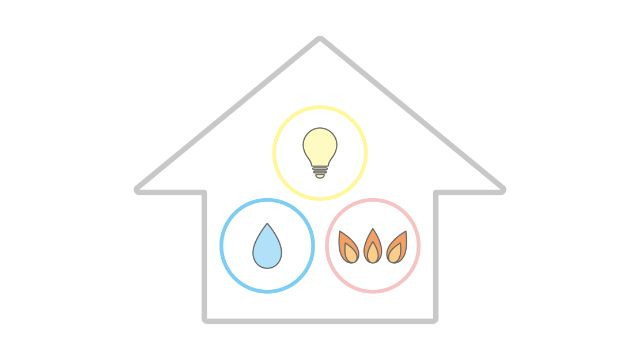How to read a Japanese address full of kanji? In this article, we will study how Japanese addresses are formed, and how to read them. We will also introduce the concepts of prefectures「都道府県 to dou fu ken」and regions「地方 chihou」which are often used in Japanese life, how to write Japanese addresses in English when sending international mail, and how to change address when moving in Japan.
Table of Contents
- Japan 47 Prefectures「都道府県」
- The 8 Japanese Regions
- How to Read Japanese Address
- How to Write Japanese Address in English
- When You Need to Change Your Address in Japan
- Summary
Japan 47 Prefectures「都道府県」

Japanese addresses start with「都道府県 to dou fu ken」. This is knowledge that is part of basic geography studies that Japanese students learn. 「1都 1道 2府 43県 ichi-to ichi-dou ni-fu yonjyuusan-ken」all together makes up 「47 都道府県」, the 47 prefectures of Japan. The number refers to how many there are, whilst the kanji character refers to the administrative district unit. Shall we learn more about them?
-
To 「都」, there’s only one: 東京都 (toukyou-to), Tokyo Metropolis
-
Dou 「道」, also only one: 北海道 (hokkai-dou), Hokkaido*
-
Fu 「府」, there’re 2: 大阪府 (oosaka-fu), Osaka*; 京都府 (kyouto-fu), Kyoto*
-
Ken 「県」, there’re 43.
(*) Have no English equivalent, and are simply translated to “prefecture”.
It seems that elementary and junior high school students in Japan memorize the names of the 47 prefectures through fun songs. Calbee, a Japanese potato chips corporation, has also released a series of potato chips that embody the taste of the 47 prefectures. It is quite useful to know the characteristics of each prefecture for living in Japan as well as travelling around Japan.
Overview of All the Japanese Prefectures
Note: In the table below, except for Tokyo, Hokkaido, Osaka and Kyoto that uses 「都」「道」「府」respectively, 「県」is not added to the remaining 43 prefectures.
|
English |
Kanji |
English |
Kanji |
English |
Kanji |
|---|---|---|---|---|---|
|
Hokkaido |
北海道 |
Ishikawa |
石川 |
Okayama |
岡山 |
|
Aomori |
青森 |
Fukui |
福井 |
Hiroshima |
広島 |
|
Iwate |
岩手 |
Yamanashi |
山梨 |
Yamaguchi |
山口 |
|
Miyagi |
宮城 |
Nagano |
長野 |
Tokushima |
徳島 |
|
Akita |
秋田 |
Gifu |
岐阜 |
Kagawa |
香川 |
|
Yamagata |
山形 |
Shizuoka |
静岡 |
Ehime |
愛媛 |
|
Fukushima |
福島 |
Aichi |
愛知 |
Kouchi |
高知 |
|
Ibaraki |
茨城 |
Mie |
三重 |
Fukuoka |
福岡 |
|
Tochigi |
栃木 |
Shiga |
滋賀 |
Saga |
佐賀 |
|
Gunma |
群馬 |
Kyoto |
京都府 |
Nagasaki |
長崎 |
|
Saitama |
埼玉 |
Osaka |
大阪府 |
Kumamoto |
熊本 |
|
Chiba |
千葉 |
Hyogo |
兵庫 |
Oita |
大分 |
|
Tokyo |
東京都 |
Nara |
奈良 |
Miyazaki |
宮崎 |
|
Kanagawa |
神奈川 |
Wakayama |
和歌山 |
Kagoshima |
鹿児島 |
|
Niigata |
新潟 |
Tottori |
鳥取 |
Okinawa |
沖縄 |
|
Toyama |
富山 |
Shimane |
島根 |
Writer's Pick
8 Regions in Japan
Are you confused about what terms such as “Kanto” and “Tohoku” mean? It is a concept of 「地方 chihou」, that is “region” or “province”, which divides the Japanese archipelago based on compass directions. Generally, it is divided into a total of 8 regions (however, there may be some differences in classifying the areas into regions depending on the term used, please refer to “Kansai/Kinki” region below). Under each region, there are「都道府県 to dou fu ken」.
1. Hokkaido Region (北海道)
*Hokkaido → 1 dou (道)
2. Tohoku Region (東北)
Aomori / Iwate / Miyagi / Akita / Yamagata / Fukushima → 6 prefectures
3. Kanto Region (関東)
*Tokyo → 1 metropolis (都)
Ibaraki / Tochigi / Gunma / Saitama / Chiba / Kanagawa → 6 prefectures
4. Chubu Region (中部)
Niigata / Toyama / Ishikawa / Fukui / Yamanashi / Nagano / Gifu / Shizuoka / Aichi → 9 prefectures
5. Kinki Region (近畿)
*Osaka, Kyoto → 2 fu (府)
Mie / Shiga / Hyogo / Nara / Wakayama → 5 prefectures
6. Chugoku Region (中国)
Tottori / Shimane / Okayama / Hiroshima / Yamaguchi → 5 prefectures
7. Shikoku Region (四国)
Tokushima / Kagawa / Ehime / Kochi → 4 prefectures
8. Kyushu Region (九州) / Okinawa Region (沖縄)
Fukuoka / Saga / Nagasaki / Kumamoto / Oita / Miyazaki / Kagoshima / Okinawa → 8 prefectures

The Japanese often use this concept of region (地方) in their daily lives. When talking about one’s birthplace or workplace, there are many cases where instead of directly mentioning the prefecture (都道府県), they would mention a broader range using ~region (~地方). For example, “I worked at a university in Kinki (近畿)”. To not mistake Kinki, or any other region, to be the name of a prefecture or city, it would be good to remember the concepts of regions (地方) which is considered basic knowledge.
Kinki region? Kansai region?
Have you heard of the Kansai (関西) region? Perhaps you’re there right at this moment. Those of you who’ve used Kansai International Airport (関西国際空港) to visit Osaka, Kyoto, etc. places, the question you should be asking is why Kansai Region (関西地方) is not included in the 8 regions of Japan.
Since the Japanese concept of regions (地方) does not follow any precise criteria, unlike administrative district units (都道府県), even if you use the term “Kansai region” which is not part of the 8 regions, the meaning still carries across. However, unlike the term “Kanto” to which Tokyo belongs that has been used and written since ancient times, the word “Kansai” only began to emerge as a concept when Edo changed its name to Tokyo, and gradually used in earnest to replace the “Kinki region”, a concept that has existed since the Heisei period.
The Kansai region thus established includes the 2 “prefectures (府)” of Osaka and Kyoto, and the 4 prefectures (県) of the Kinki region (Shiga / Hyogo / Nara / Wakayama), or in some cases 5 prefectures by adding Mie, or in other cases 6 prefectures by adding Tokushima and Tottori.
East Japan「東日本」, West Japan「西日本」
You may come across these terms East Japan「東日本」and West Japan「西日本」on train services such as JR or in newspaper articles, and may be curious about the criteria for classifying these areas. How far is east, and how far is west?
Even this concept is not clear. This is because organisations such as telecommunication companies, electrical companies, and the meteorological agency use the terms slightly differently. In any case, it is good to know as part of basic knowledge that East Japan includes Tokyo, whilst West Japan includes Kyoto.
How to Read Japanese Address

Now, let’s have a go at reading Japanese addresses. For Japanese addresses,「都道府県 to dou fu ken」as described above is followed by a sub-administrative district unit of 「市区町村 shi ku chou son」or 「市町村 shi chou son」. However, the case for Tokyo which is composed of 23 special wards (特別区) and other ordinary areas, the address composition can be slightly different with the term「区市町村 ku shi chou son」used at times.
Shall we try reading the address of the company where WeXpats Guide articles are written?
東京都渋谷区渋谷二丁目24番12号 渋谷スクランブルスクエア25階
Tokyo-to / Shibuya-ku / Shibuya Ni-choume nijuuyon-ban juuni-gou / Shibuya Sukuranburu Sukuea nijuugo-kai
After the name of the ward (区 -ku), 「町丁 chouchou」or「町名 choumei」for further subdividing the area is written -「渋谷二丁目」from the above example address. It is said that in older times, they were called “Aza” (字). If this explanation is hard to understand, you can simply think of “chouchou” or “choumei” as neighbourhood names or street names.
「渋谷二丁目24番12号」, for the sake of convenience such as lack of space or vertical/horizontal envelopes, this part of the address can be written and read in a different way. If you know the basic concept and order of Japanese addresses, you can easily search for addresses using only numbers and hyphens (ー) on Google Maps, which is super convenient when travelling. Using the example address above,「渋谷二丁目24番12号」can be written as 渋谷2-24-12.
Quick Stop >> Things to Keep in Mind when Writing/Reading Japanese Addresses
-
Banchi (番地) can be used as a whole, but is generally written as 'ban (番)'. Ex) 二丁目24番12号, 2丁目24番12号
-
When writing vertically, it is recommended to write the number corresponding to choume in kanji so that it is not confused with a hyphen. Ex) 二丁目24番12号
-
When writing horizontally, 'hyphen (ー)' is often used instead of 丁目 and 番 for convenience. In this case, 'go (号)' is omitted. Ex) 2丁目24ー12, 2ー24ー12
-
When reading an address using a hyphen, read the hyphen as 'no'. Ex) In the case of 2ー24-12, read 'ni no nijuuyon no juuni'.
What is Banchi (番地)?

「都道府県 to dou fu ken」, 「市区町村 shi ku chou son」, 「町丁 chouchou」/「町名 choumei」... seem very complicated, but in general, the most important question you’ll be asked is “What is your banchi?” In this case, just answering「渋谷二丁目24番12号」should be sufficient. Once you have properly written/read the banchi, finish up the address with the name of the building, the floor number, the room number, and you are done!
How to Write Japanese Address in English
There are times when you have to give your Japanese address to family and friends abroad, or, conversely, send mail to family and friends in Japan from abroad. Just in case, let's learn how to write Japanese addresses in English. When writing Japanese addresses in English, the order is different. Japanese-style of writing address always starts with the largest unit 「都道府県 to dou fu ken」, but English-style of writing addresses always starts with the smallest detail which is the building name+floor (for offices), building name+floor+room number (for apartments), and banchi (for houses).
SHIBUYA SCRAMBLE SQUARE 24F-25F, 2-24-12, Shibuya, Shibuya-ku, Tokyo
150-0002
Japan
Read Overview of the Japanese Postal System, which introduces the basics of using postal services in Japan.
When You Need to Change Your Address in Japan

There are certain residential procedures to carry out whenever you move in Japan, this includes changing (updating) your current address. In particular, foreign nationals must change the address on their residence card within 14 days of moving, in addition to the general moving-in/move-out report and change of address for mobile phone/credit card/bank/driver's licence.
For more about updating addresses on residence cards, please read Update Address Whenever You Move Residence.
Summary
In a tech-smart world, you can simply turn on Google Maps, look up a route, and reach your destination with little trouble. But that’s not the point! Wouldn’t it be nice to live and travel in Japan, visiting places and exploring Japan with a deeper understanding of place names and their significance? Even when referring to the same place, how to read its name can vary from place to place. Think of it as interesting trivia you picked up or collectibles to add to your Japanese fun facts.

































